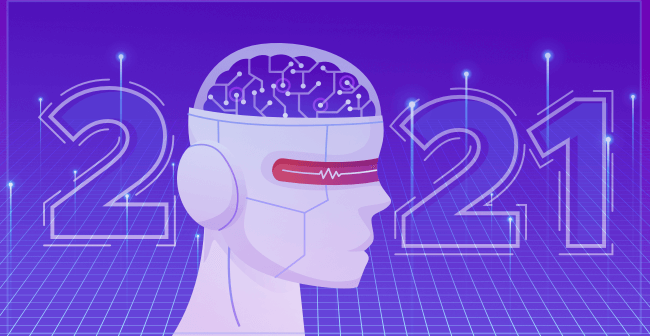AI cybersecurity, supported by machine learning, is set to be a powerful tool in the looming future. As in other sectors, human interaction has long been essential and irreplaceable in security.
While Cybersecurity today depends highly on human input, technology is beginning to outperform humans on specific tasks. Each technological improvement brings us closer to complementing human functions more effectively.
Among these advances, some areas of research are the basis of everything.
1. Definition of AI, Machine Learning, and Deep Learning in Cybersecurity
Artificial intelligence (AI): Humans design artificial intelligence (AI) to provide computers with the complete responsiveness of the human mind. This holistic discipline encompasses many others, such as machine learning and deep learning.
Machine learning (ML): uses existing behavior patterns, enabling decision-making based on past data and insights. Human intervention is still required to make some changes.
Machine learning is likely the most critical Artificial intelligence (AI) cybersecurity discipline.
Deep learning (DL): works similarly to machine learning by making decisions based on past patterns, but it adjusts independently. Currently, deep learning in Cybersecurity is within machine learning so we will focus mainly on the latter.
2. What are the 8 advantages of involving Computer-based Intelligence in Network Protection?
The objective of artificial brainpower is to reproduce human knowledge, and it has critical likely in the field of online protection.
We can train man-made intelligence systems to identify threats, recognize new malware, and shield delicate information, which could be very valuable whenever executed.
i) Man-made Intelligence Learns More Over the long haul
Man-made intelligence utilizes AI and profound learning strategies to break down network conduct and recognize deviations or security occurrences from the standard.
This considers prompt reaction and upgrades future safety efforts by impeding likely dangers with comparable characteristics. Artificial intelligence'sintelligence's consistent educational experience makes it moving for programmers to outmaneuver its insight.
ii) Computerized reasoning Distinguishes Obscure Dangers
Distinguishing all likely dangers to an organization can be overpowering because of the steadily changing strategies of programmers.
It is pivotal to take on present-day arrangements like man-made intelligence to successfully recognize and forestall hidden dangers, which can cause serious harm if undetected.
iii) Simulated Intelligence Can Deal with a Ton of Information
An organization creates considerable traffic, making it hard for network safety staff to survey every type of effort for potential physical dangers.
Man-made intelligence innovation consequently outputs and distinguishes masked dangers, smoothing out the recognition interaction and improving security.
iv) Better Weakness The executives
Given organizations' everyday dangers, simulated intelligence is fundamental in overseeing network weaknesses. It breaks down existing safety efforts to recognize weak spots, empowering organizations to zero in on essential security assignments.
This further develops critical thinking abilities and gets business frameworks quicker than the network protection workforce.
v) Better By and Large Security
Programmers continually change their strategies, making it hard to focus on security undertakings. Simulated intelligence can assist with distinguishing a wide range of assaults and focus on counteraction, in any event, while managing various dangers simultaneously.
Human blunder and carelessness can likewise present security challenges, yet man-made intelligence'sintelligence's self-learning capacities can make it exceptional to deal with them.
vi) Duplicative Cycles Lessen
Simulated intelligence can deal with the tedious and dull security undertakings that can make network safety faculty smug. It consistently distinguishes and forestalls real security dangers and performs exhaustive examinations to recognize potential security openings.
Artificial intelligence enables organizations to consistently implement their security best practices without the risk of human error or fatigue.
vii) Speeds up Location and Reaction Times
Coordinating computer-based intelligence with network protection empowers fast location and reaction to dangers, saving your organization from irreversible harm.
Simulated intelligence examines the whole framework, distinguishes dangers early, and improves on security undertakings contrasted with people.
viii) Getting Validation
Sites with client account highlights or contact structures containing delicate data require an extra security layer for insurance.
3. What can AI do for Cybersecurity?
AI and Cybersecurity have been proclaimed revolutionary and are much closer than we think. However, it is vital to approach this as a partial truth and maintain reservations regarding expectations.
The reality is that we may find relatively gradual improvements in the future. In hindsight, what may seem incremental compared to a fully autonomous future continues to outpace what we've been able to do in the past.
When we explore what security consequences machine learning and AI may have, it is crucial to highlight current cybersecurity pain points. There are many processes and aspects that we have accepted as usual for a long time, and AI technologies can help improve.
i) Human error in the configuration:
Human error is a significant part of cybersecurity weaknesses. For example, managing the proper system configuration can take much work, even with large IT teams involved.
Responsive tools could help teams find and mitigate problems that appear as network systems are replaced, modified, and upgraded.
Consider how newer Internet infrastructure, such as cloud computing, can be added to existing on-premises frameworks. In enterprise systems, IT teams must ensure compatibility to protect these systems.
Assessing the reliability of a manual configuration can be a lengthy process, as IT staff will have to combine this work with constant updates and daily tasks.
Thanks to intelligent and adaptive automation, teams could receive timely advice on newly discovered problems. They might also get advice on options or have systems automatically adjust settings as needed.
Human efficiency with repeated activities
Human efficiency is another problematic aspect of the cybersecurity sector. No manual process can be repeated ideally every time, especially in a fast-paced environment like ours.
Configuring the many endpoints in an organization individually is one of the most time-consuming tasks. Even after the initial configuration, IT teams revisit the same computers to actively fix incorrect or outdated settings that remote updates cannot resolve.
Also, when employees take it upon themselves to respond to threats, the scope of the threat can change rapidly. When unexpected difficulties arise, and humans experience delays in their attention, an AI and machine learning-based system can act with minimal delay.
ii) Fatigue due to excessive alarms about threats:
- Threat over-alarm fatigue is another weakness for organizations if not managed carefully. Attack surfaces are increasing as security layers become more elaborate and extensive. Consequently, these individual warnings leave the human teams to be the ones to analyze the possible decisions and take the necessary measures.
- A large influx of alerts makes this level of decision-making an incredibly exhausting process.
- Sometimes teams have to decide to tackle the most pressing issues first and put secondary goals aside. The use of AI in Cybersecurity can help IT teams manage more of these threats effectively and practically. Dealing with each of these threats can be much easier if you group them using automated tagging. What'sWhat's more, the machine learning algorithm can take care of solving some of the problems.
iii) Threat response time:
- Threat response time is one of the most critical metrics for the effectiveness of cybersecurity teams. Threat actors in the past used to infiltrate by exploiting network permissions and laterally disarming security a few weeks before launching their attack.
- Unfortunately, experts in the cyber defense space aren'taren't the only ones who benefit from technological innovations. Automation has also become more common in cyberattacks. Threats like the recent LockBit ransomware attacks have significantly sped up attack times. Half an hour can be enough to carry out some aggression.
- The human response can lag behind the initial attack, even with known attack types. For this reason, more often than not, many teams spend more time reacting to successful attacks than preventing attempted attacks. At the other end of the spectrum, undiscovered attacks are a danger in themselves.
- ML-assisted security can extract the data from an attack, aggregate it, and prepare it for analysis. In addition to reporting, this type of security can also recommend what steps to take to prevent further damage and prevent future attacks.
iv) The Role of AI in Cybersecurity
- Experts consider artificial intelligence in Cybersecurity encompassing various disciplines, such as machine learning cybersecurity and deep learning. Still, it is called upon to play its role.
The AI focuses on "success," while "accuracy" carries less weight. Its ultimate goal is to give a natural response to complex tasks. The AI system makes accurate and independent decisions during an actual AI run.
We design your programming to find the ideal solution in a situation rather than just reaching the challenging logical conclusion of the data set.
4. How is Machine Learning Used in Cybersecurity?
Security solutions for machine learning differ from what people imagine the AI family to be. With that said, we haven't discovered any stronger cybersecurity tools yet. Within the scope of this technology, we use data patterns to reveal the probability of an event occurring or not occurring.
i) Data classification
Data classification works by using predefined rules to assign categories to data points. Tagging these items is integral to profiling attacks, vulnerabilities, and other aspects of proactive security. This is critical to the intersection of machine learning and Cybersecurity.
ii) Data clusters
Data clusters combine the values selected during classification into groups with typical or atypical characteristics. For example, analysts can use this method when analyzing data from attacks that a system cannot yet handle.
Analysts can use these clusters to determine how an attack occurred, identify the weaknesses that the attacker exploited, and ascertain the exposed data.
iii) Synthesis of possibilities
The synthesis of possibilities allows the synthesis of new options from previous data and new unknown data sets. This is different from recommendations, as it focuses more on the chances that an action or state of a system will correspond to similar situations in the past.
iv) Predictive Forecast
Predictive forecasting is the most advanced of the ML component processes. Evaluating existing data sets enables us to achieve this benefit by predicting possible outcomes.
This technology primarily creates threat models, describes fraud prevention, protects against data exfiltration, and is a staple of many predictive endpoint solutions.
5. Examples of Machine Learning in Cybersecurity
For clarity, here are some examples that underscore the value of machine learning when it comes to Cybersecurity:
You must manage the data collected from your customers and users following these laws, which usually means that this data must be accessible for deletion upon request.
The consequences of not following these regulations carry high fines, as well as damage to the reputation of your organization.
i) User behavior security profiles
By forming custom profiles of network personnel based on user behaviors, you can customize security to suit your organization. This model can detect an unauthorized user by analyzing the deviations in his behavior. Subtle traits, such as keystrokes, can form a predictive model of threats.
By identifying the possible results of potential tampering, an ML-based security system can offer ways to reduce the potential attack surface.
ii) System Performance Security Profiles
Similar to the concept of a user behavior profile, a custom diagnostic profile of the performance of the entire computer when it is healthy can be compiled. Monitoring processor and memory usage and traits such as high Internet data usage can help identify malicious activity.
However, some users may frequently use large volumes of data through video conferencing or downloading large media files. By knowing the average system load, the algorithm can determine deviations, such as in the case of user behavior that we mentioned in an earlier ML example.
iii) Behavior-based bot blocking
Bot activity can drain the incoming bandwidth of websites. This is especially true for those who rely on Internet-based business traffic, such as owners of e-commerce stores without brick-and-mortar stores.
Regular visitors may encounter slow website performance, resulting in lost traffic and potential customers.
iv) Machine learning technology
It can identify and block bot activity even when using anonymization tools like virtual private networks. Based on data about cybercriminal behavior, the algorithm generates predictive models and proactively blocks new web addresses that show the same activity.
6. The Future of Cybersecurity
Despite the intense dialogue surrounding the future of this form of security, we still need to consider limitations.
ML needs data sets, but using them can conflict with privacy laws. Creating accurate models in software systems that train algorithms requires many data points, which doesn't quite fit with "the right to be forgotten."
Some data breaches can occur due to human identifiers, so we must explore possible solutions. One possible solution involves configuring systems to make accessing the original data virtually impossible once the software has completed training.
We also consider anonymizing the data points, but we need to examine them further to avoid bias in the program logic.
7. Three tips for tackling the future of Cybersecurity
- On the road to AI security, there are a few steps you can take to get closer to the future: Invest to ensure your technology always remains oriented toward the future. The costs of exploited vulnerabilities due to outdated technology or redundant use of manual tasks will be much higher as threats become more complicated. Staying ahead can help mitigate some risks. By using advanced solutions like Kaspersky Integrated Endpoint Security, you'll be more prepared to adapt.
- Complement your teams with AI and ML instead of replacing them. Vulnerabilities will continue to exist, as there is currently no foolproof system on the market.
- Periodically update your data policies to comply with changes in legislation. Data privacy has become a focus for government entities around the world. Therefore, it will continue to be a top concern for most businesses and organizations for the foreseeable future. Ensure that you are following the latest policies.
Conclusion
In conclusion, AI and machine learning are transforming cybersecurity by enhancing threat detection, response time, and vulnerability management. These technologies address human error, fatigue, and overwhelming threats, ultimately improving security.
While AI is not a complete solution, it offers valuable tools to augment human capabilities and strengthen cybersecurity defenses in an ever-evolving digital landscape. Embracing AI in cybersecurity is crucial for organizations to stay ahead of malicious actors and protect sensitive data and systems.















Leave a Reply